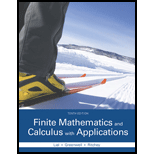
Concept explainers
Consumers’ and Producers’ Surplus Suppose that with the supply and demand for oil as in Exercise 35, the government sets the price at $264 per unit.
(a) Use the supply function to calculate the quantity that will be produced at the new price.
(b) Find the consumers’ surplus for the new price, using the quantity found in part (a) in place of the equilibrium quantity. How much larger is this than the consumers’ surplus in Exercise 35?
(c) Find the producers’ surplus for the new price, using the quantity found in part (a) in place of the equilibrium quantity. How much smaller is this than the producers’ surplus in Exercise 35?
(d) Calculate the difference between the total of the consumers’ and producers’ surplus under the equilibrium price and under the government price. Economists refer to this loss as the welfare cost of the government’s setting the price.
(e) Because of the welfare cost calculated in part (d), many economists argue that it is bad economics for the government to set prices. Others point to the increase in the consumers’ surplus, calculated in part (b), as a justification for such government action. Discuss the pros and cons of this issue.
35. Consumers’ and Producers’ Surplus Suppose the supply function for oil is given (in dollars) by
and the demand function is given (in dollars) by
(a) Graph the supply and demand curves.
(b) Find the point at which supply and demand are in equilibrium.
(c) Find the consumers’ surplus.
(d) Find the producers’ surplus.
Want to see the full answer?
Check out a sample textbook solution
Chapter 15 Solutions
Finite Mathematics and Calculus with Applications (10th Edition)
- Find the distance from the point (-9, -3, 0) to the line ä(t) = (−4, 1, −1)t + (0, 1, −3) .arrow_forward1 Find a vector parallel to the line defined by the parametric equations (x(t) = -2t y(t) == 1- 9t z(t) = -1-t Additionally, find a point on the line.arrow_forwardFind the (perpendicular) distance from the line given by the parametric equations (x(t) = 5+9t y(t) = 7t = 2-9t z(t) to the point (-1, 1, −3).arrow_forward
- Let ä(t) = (3,-2,-5)t + (7,−1, 2) and (u) = (5,0, 3)u + (−3,−9,3). Find the acute angle (in degrees) between the lines:arrow_forwardA tank initially contains 50 gal of pure water. Brine containing 3 lb of salt per gallon enters the tank at 2 gal/min, and the (perfectly mixed) solution leaves the tank at 3 gal/min. Thus, the tank is empty after exactly 50 min. (a) Find the amount of salt in the tank after t minutes. (b) What is the maximum amount of salt ever in the tank?arrow_forwardpleasd dont use chat gptarrow_forward
- Draw the vertical and horizontal asymptotes. Then plot the intercepts (if any), and plot at least one point on each side of each vertical asymptote.arrow_forwardDraw the asymptotes (if there are any). Then plot two points on each piece of the graph.arrow_forwardCancel Done RESET Suppose that R(x) is a polynomial of degree 7 whose coefficients are real numbers. Also, suppose that R(x) has the following zeros. -1-4i, -3i, 5+i Answer the following. (a) Find another zero of R(x). ☐ | | | | |│ | | | -1 བ ¢ Live Adjust Filters Croparrow_forward

 Linear Algebra: A Modern IntroductionAlgebraISBN:9781285463247Author:David PoolePublisher:Cengage Learning
Linear Algebra: A Modern IntroductionAlgebraISBN:9781285463247Author:David PoolePublisher:Cengage Learning

